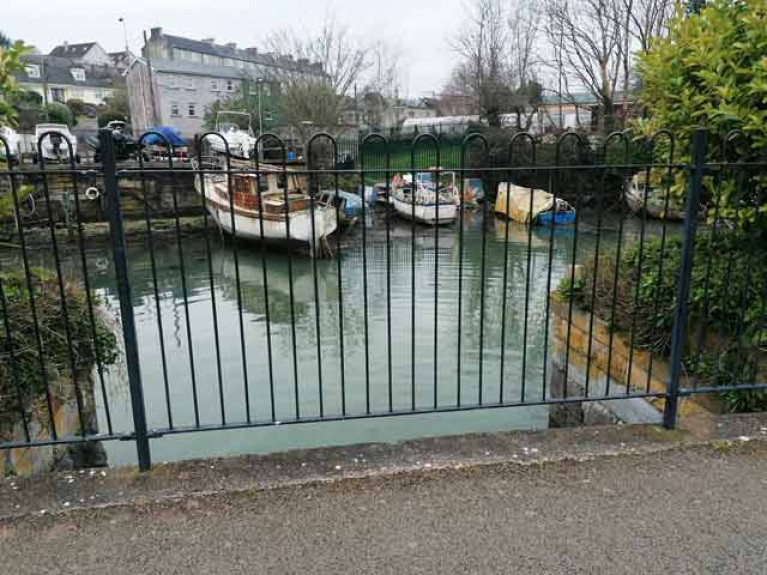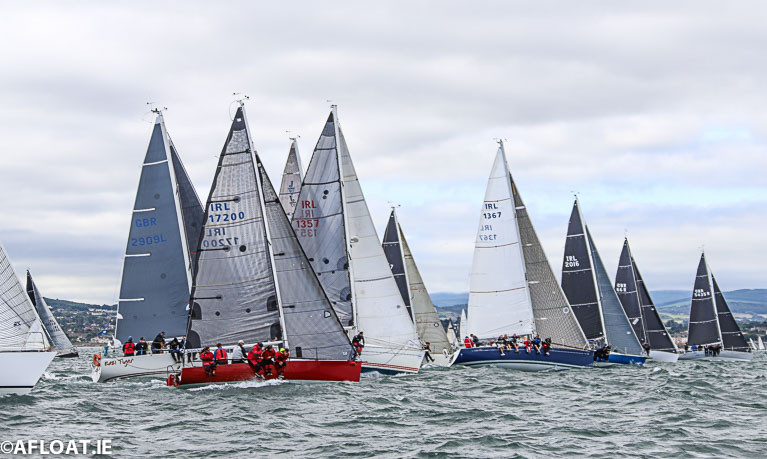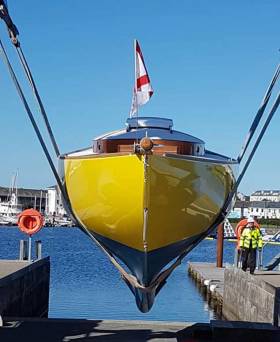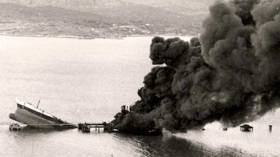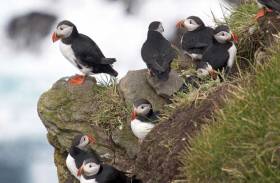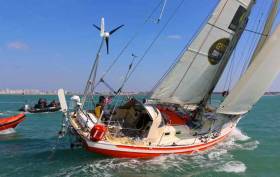Displaying items by tag: Tom MacSweeney
The annual report of the Marine Casualty Investigation Board (MCIB) for last year came a bit late this year to make as much impact as it could. It arrived in my email at the start of the month, a time when sailing and many watersports are not particularly active as the season has wound down and boats are laid up.
The Board has had a bit of a torrid time over the European Court decision on the appointment of new members, and legislation in this regard was still passing through the Dáil when the report was published. Also still in train was the review ordered by Transport Minister Eamon Ryan, to assess current organisational structures for marine casualty investigation in Ireland.
However, these should not take from the warnings of Board Chairperson Claire Callanan about the dangers in watersports. She includes sailing in her list, with rowing, canoeing and kayaking.
"The occurrence of so many incidents involving sailing, rowing, canoeing and kayaking in the last few years is of particular safety concern," she wrote in her introductory note to the report. "The MCIB is strongly encouraging all organisations, "especially clubs and commercial entities associated with water sports and water recreational activities, to audit their safety systems and to have regard to the Code of Practice and all guidelines or recommendations issued by any governing sports bodies. Safety in this sector is a particular concern. It highlights the dangers associated with activities that people participate in at many levels, including recreational and sporting. "It is imperative that any individual or group engaged in this activity realise the importance of adequate route planning and has an understanding of the watercourse," she wrote.
"incidents involving sailing, rowing, canoeing & kayaking is of particular safety concern"
This is also a trend reported by marine casualty investigation organisations around Europe. That is advice that clubs will have to take aboard. There is a factor to be considered, and that is the increased recreational activity on the water arising from stay-at-home holidays due to the Covid pandemic.
Clubs and sailing schools
That also highlights the importance of club membership and training. Clubs and sailing schools make safety on the water a vital issue for members. Those not members of clubs don't have to adhere to and may not be aware of safety requirements.
Reclassifying jet skis
One other safety aspect which needs attention is whether Ireland should follow the UK decision to take action to control jet skis, where there does not seem to be strong organisational usage control. The UK's Department of Transport has announced that it intends to "reclassify jet skis, speed boats and other recreational and personal watercraft to make users subject to the same laws and safety obligations as applied to those who operate ships. This would clamp down on dangerous, reckless driving of jet skis to protect the public and coastal areas," it says.
The UK Royal Yachting Association, while supporting the change, says the definition of watercraft is too broad and could affect other craft not causing problems. "There are aspects which are not appropriate for all watercraft. We have suggested changes," the RYA says.
Catch Up With Golden Globe Race Solo Sailor Gregor McGuckin
Two and a half years after Dublin solo sailor Gregor McGuckin returned from the Golden Globe Race, the strong public interest in Gregor's story led me to Malahide Marina Boatyard in County Dublin for this week's podcast.
As regular Afloat readers will know, McGuckin was in the middle of the 2018 Golden Globe Race when he was dismasted in the Indian Ocean while in third place and then, with a jury rig, went to the aid of another sailor whose yacht had also been badly damaged and who had suffered serious injury.
 Being dismasted during a shattering 360 degree roll in the tumultuous Southern Indian Ocean in the roughest part of the Golden Jubilee Golden Globe Race would have created an extreme survival situation for most sailors. But after it happened to Gregor McGuckin with his vintage Biscay 36 ketch Hanley Energy Endurance, he soon heard that, 90 miles away, rival skipper Abilash Tomy was in an even worse situation, dismasted and incapacitated by injury.
Being dismasted during a shattering 360 degree roll in the tumultuous Southern Indian Ocean in the roughest part of the Golden Jubilee Golden Globe Race would have created an extreme survival situation for most sailors. But after it happened to Gregor McGuckin with his vintage Biscay 36 ketch Hanley Energy Endurance, he soon heard that, 90 miles away, rival skipper Abilash Tomy was in an even worse situation, dismasted and incapacitated by injury.
His courage was an inspiration, Dublin singer and songwriter Dan Fitzpatrick said, for the 20-minute musical voyage around five oceans which he has composed and about which we've already told you on Afloat.
Catch up with what Gregor's doing now in the podcast below.
"The Lady Min is pretty special, and she performs really well…."
The world was a great place to be when the Lady Min was an idea, and there was a 'can do' attitude in West Cork.
Simon O'Keeffe is carrying on with that type of determination and is my guest this week on the Afloat Podcast as we talk about his restoration, being done at Tiernan Roe's boatyard in Ballydehob, of the Lady Min whose heritage and association with Simon's family goes back to 1902.
 The Lady Min prior to her restoration in 2018
The Lady Min prior to her restoration in 2018
 The story today - preparing for the cabin to be installed on Lady Min
The story today - preparing for the cabin to be installed on Lady Min
It's been two years since he first told me of his determination to restore the boat, now 118-years-old and which was, in her heyday, a thorn in the side of the then yacht racing fraternity of Cork Harbour!
 Another stage of Lady Min's restoration at Roe Boats
Another stage of Lady Min's restoration at Roe Boats
It's a story to hear direct from the man who has put a lot of money, time and effort into his personal project. He is determined that the Lady Min will go afloat again early next summer.
 Hey-day- The modern appearance of Lady Min’s hull makes it all the more remarkable that she was designed and built in Schull in 1902 Photo: courtesy Dermot O’Donoghue
Hey-day- The modern appearance of Lady Min’s hull makes it all the more remarkable that she was designed and built in Schull in 1902 Photo: courtesy Dermot O’Donoghue
I began this week's podcast by asking Simon to outline the latest stage of the restoration work.
Listen to the Podcast here.
Sailing & Its Widespread Opportunities Should Be Noted
Walking along the riverside in Cork Harbour in the past few days of good weather the harbour waters looked inviting, but as I thought of the pleasure of having the sails up, helm in hand, boat moving through the water, the sound of a bow wave ... the emptiness of the harbour waters told another tale… Along the river walk, I saw boats still lying fenced in.
While Irish Sailing negotiated the difficulties of a return to the water and drafted a plan for discussion with clubs, I pondered over why canoeing had been named as the only waterborne sport included in the initial suggestions for a return of watersports.
So I pursued that with a ‘contact’ of mine, as journalists are wont to have, within the Department of Transport, Tourism and Sport. That single-handed sailing was not mentioned surprised me. My ‘source’ told me that canoeing had been considered because it was “a safe, individual sport, hence social distancing would not be a problem.”
So, why not single-handed sailing – Lasers, Toppers, Optimists – even giving younger sailors a chance to get on the water … The response was that ‘crewed yachts’ had been the focus of concern, where ‘social distancing’ could not be observed…
Now, the core of deciding to go afloat in sailing is based on a combination of self-assessment - of safety, responsibility and risk and that has been put forward by Irish Sailing. I understand the problems of ‘close quarters’ aboard a racing or cruising yacht. As the national sailing authority has suggested, however, what about enabling double-handed sailing, households, family sailing, solo sailing. They should surely be considered, otherwise, a season of little opportunity is ahead.
"overall decisions about local sailing are on hold depending upon what arises from Irish Sailing’s updated plan"
From clubs around the South this week the only positive indicator was that the annual Cobh-to-Blackrock Race, always a well-patronised event, has the best prospect of going ahead because it is not scheduled until September. Decisions are awaited in regard to Glandore Classic Boats in July, but the present uncertainty may affect overseas entrants. Calves Week is still scheduled for August, but overall decisions about local sailing are on hold depending upon what arises from Irish Sailing’s updated plan.
Chief Executive Harry Hermon told me that “the anticipation is that we will be able to go afloat to some degree in Phase 1 of restrictions.”
Hopefully, that will happen but, while not being critical of canoeing as a sport, I’d like to see to more recognition from the Department of Sport of the strong support for sailing and its widespread opportunities.
Listen to the podcast below:
The Joys & Language of Yacht Racing
What is the most important, challenging and decisive part of yacht racing?
“The start of the race.”
That was what experienced skippers and crews told me - on the start line a race could be won and lost.
So, when I ‘stepped up’ from dinghy racing and what was described to me by the “cruiser class” as “the wet ass brigade” I was well aware of start line importance.
But I found there was one major difference - Language and the force and manner of its expression!
My introduction to this was in my first race in my first cruiser, my first ‘Scribbler’ – a Ruffian 23. Two weeks after I bought her and two days after launching, she was on the start line for the National Quarter Ton Championships raced out of the Royal Cork YC at Crosshaven. It was a heavy weather day, some 30 years ago, so windy that racing was inside Cork Harbour because outside the conditions were too severe.
My experience up to then was of dinghy racing, Mirrors and 12ft. Vagabonds in Monkstown Bay and National 18 crewing. Scribbler’s crew was me on the helm, with my young son and his friend. On the start line over 20 yachts of various sizes and design circled each other in what was then the 10-5-minutes start sequence. Helming 23-feet amongst them was a bit different from 12-foot dinghies as they prowled each other.
When the start gun went they all charged for the same part of the line – as close as they could get to the stern of the committee boat, with roaring and shouting erupting.
Some epithets I never thought I’d hear from the refinements of the RCYC which I had joined only shortly before entering the Championships, were uttered. Wow, the language, the shouts of “Up, Up, Up you….!!” Retorts of: “You’ve no ……..rights…” “Get out of there….” (the moderate comment) and more …
How we got across the line without being thumped or banging into another boat I can never remember.
The course was along the edge of the Aghada shoreline, then a nice freeway before the ESB ruined it by turning it into an obstacle course with their waterborne protrusions associated with the onshore power station. We rounded the weather mark and up went kites. In the days before I became more cautious about spinnakers, we hauled too, for a speedy broad reach - then we came to the gybe mark and, well, that didn’t go too well…a series of three photos appeared of Scribbler afterwards captioned – “going, going, gone... The third showed a hand grasping the portside cockpit edge with quite a lot of the hull visible!
Scribbler came upright into the wind and shook herself, possibly wondering about the idiot on the helm. We scrambled to get the kite off, shook ourselves as well, then carried on after the fleet and finished the race.
Back in the clubhouse one of the other skippers approached me, the ‘newbie’ of the fleet and observed that we had shown a fair turn of speed on the reach… “Haven’t had the boat long?” he queried… “Not long,” I agreed.
That was “courageous,” - I like to think that’s the word he used! - “a three-sail reach in those conditions,” he observed. So I asked what he meant and was told: “you had all three sails up, main, jib, spinnaker…”
“Oh,” I replied. “Should I have taken one down…?”
So I learned a bit more about sailing – and about language…
Those thoughts came to mind this week when I heard a man claim on a national current affairs radio programme that a ‘scientific study’ conducted it appeared in just three days, rather a short timespan for scientific study, had revealed that even speaking was dangerous because COVID 19 could be emitted in speech. Sport, he said, might never be possible again for a very long time. Spectators and players would all have to wear masks because: “Can you imagine how dangerous a place it would be with thousands of spectators roaring and shouting at a match?”
Whatever about that scenario, I thought, if speech has to be controlled, it would make sailing so quiet that racing start lines would never be the same again, not to mind crews full of masked individuals.
At least the skipper might be muted!
Listen to the podcast below:
More Young Sailors Are Needed on Racing Yachts
The shortage of young sailors on racing boats is a universal problem.
That is the opinion of Andy Anderson, President of the International Council of Yacht Clubs. It is one of the issues which clubs need to deal with in a modern world with a different approach to the sport, he says
One of the greatest attractions of sailing for him is that “it brings you in close touch with Nature,” which underlines the importance of sustainability in sailing and its involvement with the environment.
"Sailing for him is that “it brings you in close touch with Nature"
This, he believes, will become “an exponential issue over the next few years.”
He is my guest on this week’s podcast, discussing a wide variety of sailing issues, viewed from his perspective of a lifetime in the sport in New Zealand where he has been Commodore of the Royal New Zealand Yacht Club. He emphasised the importance of club structures in fostering the development of sailing and began the interview by referring to the public perception of sailing.
Listen to the Podcast below
The Dublin Bay 21s: The World's Oldest Cruiser Racer Class
I won’t be challenging Hal Sisk’s confident declaration that he is Chairman of “the world’s oldest cruiser-racer class!”
His offer to anyone to challenge him sounded across Kilrush Boatyard to where I had driven over 400 kilometres from Cork to see a restored Dublin yacht, saved from rotting in a Wicklow farmyard, returned to the waters of Clare on the edge of the Shannon Estuary and which is bound, with others of the same maritime vintage, to be returned to the waters of Dublin Bay, by sail from Arklow after transportation thereto by road from the Banner county.
If all that seems a convoluted story, just add into the mix that it’s all to do with a major error by the same Class which caused controversy, division and dissension amongst its members because the rig of the same boats was changed. That was from gaff to Bermudan, which put too much strain and pressure on the craft, after which they had a sojourn in an Arklow boatyard that closed down, languished for 30 years in a Wicklow farmyard where they nearly rotted totally away, but from which they were recovered and transported to Kilrush for restoration. Next step is a return to an original rig that dates back to the last century, which will be accompanied by modern sails from Cork.
"Those of us present were part of an epoch-making day of Irish sailing history"
If you’re still keeping up with me, this is the story of rebreathing life into the Dublin Bay 21 Class where the canary yellow of Naneen seemed to even dominate the sunshine and the sparkling blue waters of Kilrush as she was launched after her restoration in front of a gathering of sailors from many parts of the country this week, assembled at the invitation of the said Hal Sisk whose request to be present to witness the occasion was not to be turned down. It was, in fact, a great day to be in the Kilrush yard. Those of us present were part of an epoch-making day of Irish sailing history, a day which was a tribute to those whose determination has brought back to life the 114-year-old Naneen and will result in the Class owning the restored Dublin Bay 21s.
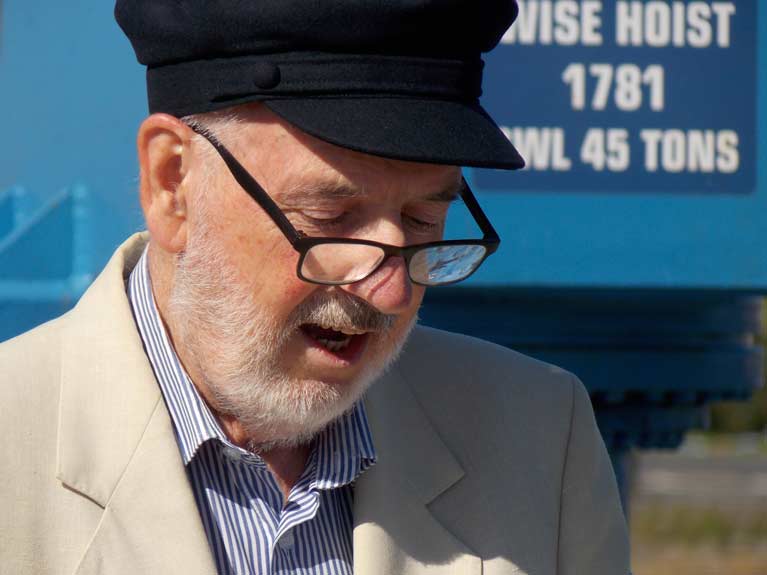 Fionan De Barra at the launch ceremony Photo: Afloat. Listen to the podcast below.
Fionan De Barra at the launch ceremony Photo: Afloat. Listen to the podcast below.
The best way to appreciate what has been done is to listen to my Podcast interview here with the Class Secretary, Fionán de Barra. I recorded so many interviews at Kilrush that they will make a special edition of my programme, THIS ISLAND NATION and my colleague, the estimable WM Nixon, tells me he will provide further elucidation about this project in his blog on Saturday here.
The families of the 50 victims of the Betelgeuse oil tanker tragedy at Whiddy Island in Bantry Bay have decided to take legal action against the State.
The French-Irish Association of Relatives and Friends of the Betelgeuse are applying to the High Court to change the death certificates of those who died to reflect what they claim to be the Irish State’s failure to address multiple unlawful safety failings which, they claim, caused their deaths.
It is forty years since the explosion which blew the tanker apart at the Whiddy oil terminal.
Maritime lawyer Michael Kingston is Vice-President of the Relatives and Friends Association. His father, Tim, was one of those killed. He announced the legal action at the Mother Jones Summer School in Cork, where he said the relatives are also seeking a State apology.
“They were left to die in atrocious circumstances and the State failed in its duty to ensure safe operations and failed to show any compassion, have issued no apology and have ignored the approaches made to them by the Betelgeuse relatives,” he told me.
A public funding appeal has been launched to raise money for the legal action.
Michael Kingston details this and what the relatives want from the Government in this week’s Podcast. I asked him first why the relatives were still so angry over the tragedy forty years ago.
Listen to the podcast (below) and also listen to the powerful letter from Jeanette Ravale (above) – whose husband, Marcel, was killed when the Betelgeuse exploded…She has visited Bantry several times. This letter was read at the 40th-anniversary commemoration in Bantry Cemetery in January by former French Consul in Cork, Francoise Letellier and again at the Mother Jones Summer School.
Sailors Asked To Help Spot Migrating Puffins
I remember when I first saw the Puffin seabirds.
It was my first time sailing along the Kerry coastline and it was off Portmagee, on the appropriately named Puffin Island.
We had closed the small Island south of Valentia which is a wild bird conservancy for a look and it was, for me, a magical moment that I always remember.
Crowded along the cliff face, some in the water, I saw Puffins about which I’d heard so much, up close for the first time. My immediate image association was with clowns I had seen as a youngster at circus performances. The facial expressions, seen close-up through binoculars, their colour from blue to yellow and red striped beaks, the webbed orange-red feet, the waddling gait, and the way they bobbed around on the water.
"As sailors, we should be interested in the welfare of seabirds which can tell us so much about the marine environment"
I’ve seen them since, from a distance around the Skelligs, Horn Head in Donegal, on the Cliffs of Moher and the Great Saltee and why I’m telling you about them is because their hormones are driving them back to Ireland. As their European population has suffered a decline, the shores of our island nation are an important location for them to breed. I’ve been told by BirdWatch Ireland, the national voluntary organisation which protects Ireland's birds and habitats, that this is part of a huge seabird migration underway to Ireland that is hidden from the eyes and ears of most, but sailors may see it and can help. A special website has been set up for the purpose here.
As sailors, we should be interested in the welfare of seabirds which can tell us so much about the marine environment.
For me, the mention of Puffins, so synonymous with the sea, brought back memories of earlier sailing days. There are many other species on the way to our shores. You can hear more about all of this on my Podcast with Niall Hatch of BirdWatch.
• Listen to the Podcast below
Golden Globe Race Investigation Report Not Available Until May
The last competitor still at sea of the eighteen yachts which started the Golden Globe Race last July is not expected to finish back in France until the middle of May. Finnish sailor Tapio Lehtinen is in fifth place in the South Atlantic and has reported to Race Control that the hull of his Gaia 36, Asteria, is covered in barnacles, making progress very slow at an average of 50 nautical miles a day.
That means that the result of an investigation into the race, being carried out by the man who won the first Golden Globe, back in 1968/69, Sir Robin Knox Johnston, will not be made public until then.
That investigation began after mounting criticism of the solo race which forced its founder, Don McIntyre, to defend it after several Skippers had to be rescued. Ireland’s Gregor McGuckin was amongst those who were rescued.
“Sir Robin is undertaking a comprehensive investigation into all issues surrounding the storm tactics of GGR entrants, rig designs and the events that have led to dismasting's and three rescues in the Race,” said McIntyre, writing on the Race website. “This very thorough report is widely anticipated and will be released at the conclusion of the race.”
He added that he was “surprised at the outcome of some of these storms and dismastings that have resulted” but defended the race as “very responsible” an “incredible challenge” which should continue and that “no one should ever kill off the human spirit of adventure…”
Response to McIntyre’s defence of the solo race has varied from supporters to critics and indicated mixed views from within and outside sailing. Questions have been raised, however, about the race, including allegations that it is irresponsible, adds nothing to sailing, puts rescuers under pressure and that the consequences of what happened this year will be far-reaching.
Sir Robin Knox Johnston’s investigation report will be eagerly awaited.
• More about this in Tom MacSweeney’s Podcast. Listen here.



























